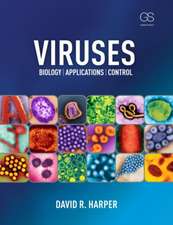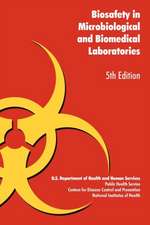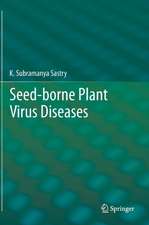Enzymology and Molecular Biology of Carbonyl Metabolism 4: Advances in Experimental Medicine and Biology, cartea 328
Editat de Henry Weiner, David W. Crabb, T. Geoffrey Flynnen Limba Engleză Paperback – 5 noi 2012
Din seria Advances in Experimental Medicine and Biology
- 9%
 Preț: 719.56 lei
Preț: 719.56 lei - 5%
 Preț: 717.00 lei
Preț: 717.00 lei - 5%
 Preț: 717.00 lei
Preț: 717.00 lei - 15%
 Preț: 640.24 lei
Preț: 640.24 lei - 5%
 Preț: 715.71 lei
Preț: 715.71 lei - 5%
 Preț: 716.28 lei
Preț: 716.28 lei - 20%
 Preț: 691.93 lei
Preț: 691.93 lei - 5%
 Preț: 1031.00 lei
Preț: 1031.00 lei - 5%
 Preț: 820.42 lei
Preț: 820.42 lei - 5%
 Preț: 716.28 lei
Preț: 716.28 lei - 15%
 Preț: 641.38 lei
Preț: 641.38 lei - 5%
 Preț: 717.20 lei
Preț: 717.20 lei - 5%
 Preț: 715.35 lei
Preț: 715.35 lei - 5%
 Preț: 1113.83 lei
Preț: 1113.83 lei - 20%
 Preț: 1161.71 lei
Preț: 1161.71 lei - 5%
 Preț: 1170.51 lei
Preț: 1170.51 lei - 18%
 Preț: 1119.87 lei
Preț: 1119.87 lei - 5%
 Preț: 1288.48 lei
Preț: 1288.48 lei - 5%
 Preț: 1164.67 lei
Preț: 1164.67 lei - 5%
 Preț: 1101.73 lei
Preț: 1101.73 lei - 18%
 Preț: 1123.67 lei
Preț: 1123.67 lei - 5%
 Preț: 1435.64 lei
Preț: 1435.64 lei - 20%
 Preț: 1044.10 lei
Preț: 1044.10 lei - 18%
 Preț: 946.39 lei
Preț: 946.39 lei - 5%
 Preț: 292.57 lei
Preț: 292.57 lei - 18%
 Preț: 957.62 lei
Preț: 957.62 lei - 18%
 Preț: 1235.76 lei
Preț: 1235.76 lei - 5%
 Preț: 1231.55 lei
Preț: 1231.55 lei - 5%
 Preț: 1292.30 lei
Preț: 1292.30 lei - 5%
 Preț: 1102.10 lei
Preț: 1102.10 lei - 18%
 Preț: 1132.81 lei
Preț: 1132.81 lei - 5%
 Preț: 1165.19 lei
Preț: 1165.19 lei - 5%
 Preț: 1418.48 lei
Preț: 1418.48 lei - 5%
 Preț: 1305.63 lei
Preț: 1305.63 lei - 18%
 Preț: 1417.72 lei
Preț: 1417.72 lei - 18%
 Preț: 1412.99 lei
Preț: 1412.99 lei - 24%
 Preț: 806.15 lei
Preț: 806.15 lei - 18%
 Preț: 1243.29 lei
Preț: 1243.29 lei - 5%
 Preț: 1429.44 lei
Preț: 1429.44 lei - 5%
 Preț: 1618.70 lei
Preț: 1618.70 lei - 5%
 Preț: 1305.12 lei
Preț: 1305.12 lei - 18%
 Preț: 1124.92 lei
Preț: 1124.92 lei - 5%
 Preț: 1097.54 lei
Preț: 1097.54 lei - 15%
 Preț: 649.87 lei
Preț: 649.87 lei - 5%
 Preț: 1097.54 lei
Preț: 1097.54 lei - 18%
 Preț: 945.79 lei
Preț: 945.79 lei - 5%
 Preț: 1123.13 lei
Preț: 1123.13 lei - 20%
 Preț: 816.43 lei
Preț: 816.43 lei
Preț: 397.07 lei
Preț vechi: 417.96 lei
-5% Nou
Puncte Express: 596
Preț estimativ în valută:
75.99€ • 78.50$ • 63.24£
75.99€ • 78.50$ • 63.24£
Carte tipărită la comandă
Livrare economică 26 martie-09 aprilie
Preluare comenzi: 021 569.72.76
Specificații
ISBN-13: 9781461362593
ISBN-10: 1461362598
Pagini: 656
Ilustrații: XIV, 637 p.
Dimensiuni: 178 x 254 x 34 mm
Greutate: 1.12 kg
Ediția:Softcover reprint of the original 1st ed. 1993
Editura: Springer Us
Colecția Springer
Seria Advances in Experimental Medicine and Biology
Locul publicării:New York, NY, United States
ISBN-10: 1461362598
Pagini: 656
Ilustrații: XIV, 637 p.
Dimensiuni: 178 x 254 x 34 mm
Greutate: 1.12 kg
Ediția:Softcover reprint of the original 1st ed. 1993
Editura: Springer Us
Colecția Springer
Seria Advances in Experimental Medicine and Biology
Locul publicării:New York, NY, United States
Public țintă
ResearchCuprins
Aldehyde Dehydrogenases—The 1992 Perspective.- Metabolic Role of Aldehyde Dehydrogenase.- Effects of Aldehyde Products of Lipid Peroxidation on the Activity of Aldehyde Metabolizing Enzymes in Hepatomas.- Metabolic Interactions of 4-Hydroxynonenal, Acetaldehyde and Glutathione in Isolated Liver Mitochondria.- Biological Role of Human Cytosolic Aldehyde Dehydrogenase 1: Hormonal Response, Retinal Oxidation and Implication in Testicular Feminization.- Human Cytosolic Aldehyde Dehydrogenase in Androgen Insensitivity Syndrome.- The Use of Immortalized Mouse L1210/OAP Cells Established in Culture to Study the Major Class 1 Aldehyde Dehydrogenase-Catalyzed Oxidation of Aldehydes in Intact Cells.- Enhanced Transcription of the Cytosolic ALDH Gene in Cyclophosphamide Resistant Human Carcinoma Cells.- Attempts to Increase the Expression of Rat Liver Mitochondrial Aldehyde Dehydrogenase in E. coli by Altering the mRNA.- Preliminary Characterization of the Rat Class 3 Aldehyde Dehydrogenase Gene.- Human High-Km Aldehyde Dehydrogenase (ALDH3): Molecular, Kinetic, and Structural Features.- Overexpression or Polycyclic Aromatic Hydrocarbon-Mediated Induction of an Apparently Novel Class 3 Aldehyde Dehydrogenase in Human Breast Adenocarcinoma Cells and Its Relationship to Oxazaphosphorine-Specific Acquired Resistance.- Tumor-Associated Aldehyde Dehydrogenase (ALDH3): Expression in Different Human Tumor Cell Lines with and without Treatment with 3-Methylcholanthrene.- Sexual Differentiation in the Induction of the Class 3 Aldehyde Dehydrogenase.- Mouse Class 3 Aldehyde Dehydrogenases: Positive and Negative Regulation of Gene Expression.- Human Stomach Aldehyde Dehydrogenase, ALDH3.- Bovine Corneal Aldehyde Dehydrogenases: Evidence for Multiple Gene Products (ALDH3 and ALDHX).-Carbonyl-Metabolizing Enzymes and Their Relatives Recruited as Structural Proteins in the Eye Lens.- Members of the ALDH Gene Family are Lens and Corneal Crystalline.- Retinoic Acid Synthesis in the Developing Retina.- Human Liver High Km Aldehyde Dehydrogenase (ALDH4): Properties and Structural Relationship to the Yeast Glutamic ?-Semialdhyde Dehydrogenase.- Effect of Some Compounds Related to Disulfiram on Mitochondrial Aldehyde Dehydrogenase in Vitro and in Vivo.- Photoaffinity Labeling of Aldehyde Dehydrogenase from Horse Liver by P1-N6-(4-Azidophenylethyl) Adenosine-P2[4-(3-Azidopyridinio)Butyl] Diphosphate.- Aldehyde Dehydrogenase: Aldehyde Dehydrogenation and Ester Hydrolysis.- Is the Single Site Binding Model for Aldehyde Dehydrogenase an Oversimplification? The One-Site, Two-Site Debate Revisited.- Crystallization and Preliminary X-Ray Analysis of Bovine Mitochondrial Aldehyde Dehydrogenase and Human Glutathione-Dependent Formaldehyde Dehydrogenase.- Aldo-Keto Reductases: An Overview.- Location of an Essential Arginne Residue in the Primary Structure of Pig Aldose Reductase.- Cys298 Is Responsible for Reversible Thiol-Induced Variation in Aldose Reductase Activity.- Substrate Specificity of Reduced and Oxidized Forms of Human Aldose Reductase.- Kinetic Alteration of Human Aldose Reductase by Mutagenesis of Cysteine Residues.- Inhibition of Aldose Reductase by (2, 6-Dimethylphenylsulphonyl) Nitromethane: Possible Implications for the Nature of an Inhibitor Binding Site and a Cause of Biphasic Kinetics.- Sepiapterin Reductase and ALR2 (“Aldose Reductase”) from Bovine Brain.- Polymorphisms of the Aldose Reductase Locus (ALR2) and Suseptibility to Diabetic Microvascular Complications.- Polycyclic Aromatic Hydrocarbons and Phenolic Antioxidants do notSignificantly Induce Carbonyl Reductase in Human Cell Lines.- The Purification and Properties of a Novel Carbonyl Reducing Enzyme from Mouse Liver Microsomes.- Properties and Stereoselectivity of Carbonyl Reductases Involved in the Ketone Reduction of Warfarin and Analogues.- Activation of Pulmonary Carbonyl Reductase by Aromatic Amines and Pyridine Ring-Containing Compounds.- Unique Dihydrodiol Specific Dehydrogenase of Bovine Liver: Inhibition Studies and Comparison with Aldo/Keto Reductase.- Carbonyl Reduction by 3?-HSD from Comamonas testosteroni— New Properties and Its Relationship to the Scad Family.- Substrate Specificity of Alchohol Dehydrogenases.- The Influence of pH on the Substrate Specificity and Stereoselectivity of Alcohol Dehydrogenase from Horse Liver.- The Catalytic Specificity of Liver Alcohol Dehydrogenase: Vitamin A Alcohol and Vitamin A Aldehyde Activities.- A Synthetic Approach to Analysis of the Structural Zinc Site of Alcohol Dehydrogenase.- Pyrophosphate Binding Site.- Site-Directed Mutagenesis of Mammalian Alcohol and Sorbitol Dehydrogenases Map Functional Differences within the Enzyme Family.- Horse Liver Alcohol Dehydrogenase-S-Isozyme: Confirmation of the Primary Structure by Protein Sequencing and Ion Spray Mass Spectrometry.- Mixed Substrate Experiments with Class III (?) Alcohol Dehydrogenases from Human and Pig Liver and Stomach.- Glutathione-Dependent Formaldehyde Dehydrogenase/ClassIII Alcohol Dehydrogenase: Further Characterization of the Rat Liver Enzyme.- Class IV Alcohol Dehydrogenase: Structure and Function.- The Oxidation of Aldehydes by Horse Liver Alcohol Dehydrogenase.- Effect of Glycation Upon Activity of Liver Alcohol Dehydrogenase.- Kinetically Specific Spin-Label Substrates of Liver Alcohol Dehydrogenase and of LiverAldehyde Dehydrogenase.- Fluorescence Studies of Ternary Complexes of Liver Alcohol Dehydrogenase.- Evolutionary Relationships of Branched Chain and Non-Specific Alcohol and Aldehyde Dehydrogenases.- Enzyme and Isozyme Developments within the Medium-Chain Alcohol Dehydrogenase Family.- Tissue Distribution of Alcohol and Sorbitol Dehydrogenase mRNAs.- The Role of Alcohol and Aldehyde Dehydrogenases in Alcohol-Related Diseases: Clinical Studies of Molecular Markers.- Regulation of the Human Alcohol Dehydrogenase Genes ADH1, ADH2, and ADH3: Differences in cis-Acting Sequences at CTF/NF-1 Sites.- DNA Elements Mediating Retinoid and Thyroid Hormone Regulation of Alcohol Dehydrogenase Gene Expression.- Modulation of Hepatic and Renal Alcohol Dehydrogenase Activity and mRNA by Steroid Hormones in Vivo.- Alcohol- and Aldehyde-Dehydrogenase: Modulation by Biogenic Amine Metabolites, Neuropeptides and Psychoactive Agents.- Microbial Alcohol, Aldehyde, and Formate Ester Oxidoreductases.- Carbonyl Metabolising Enzymes in Alkane-Grown Microorganisms.





